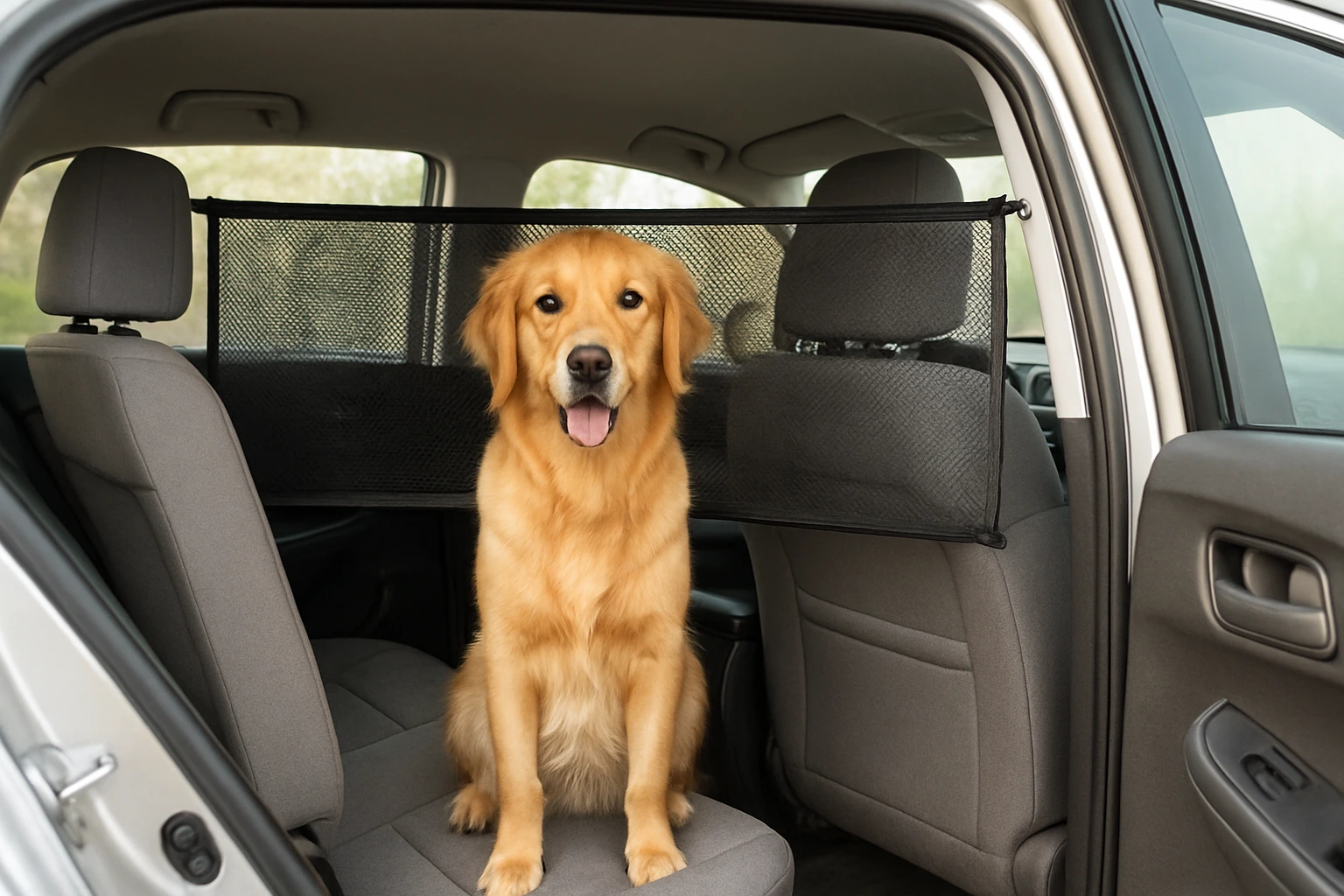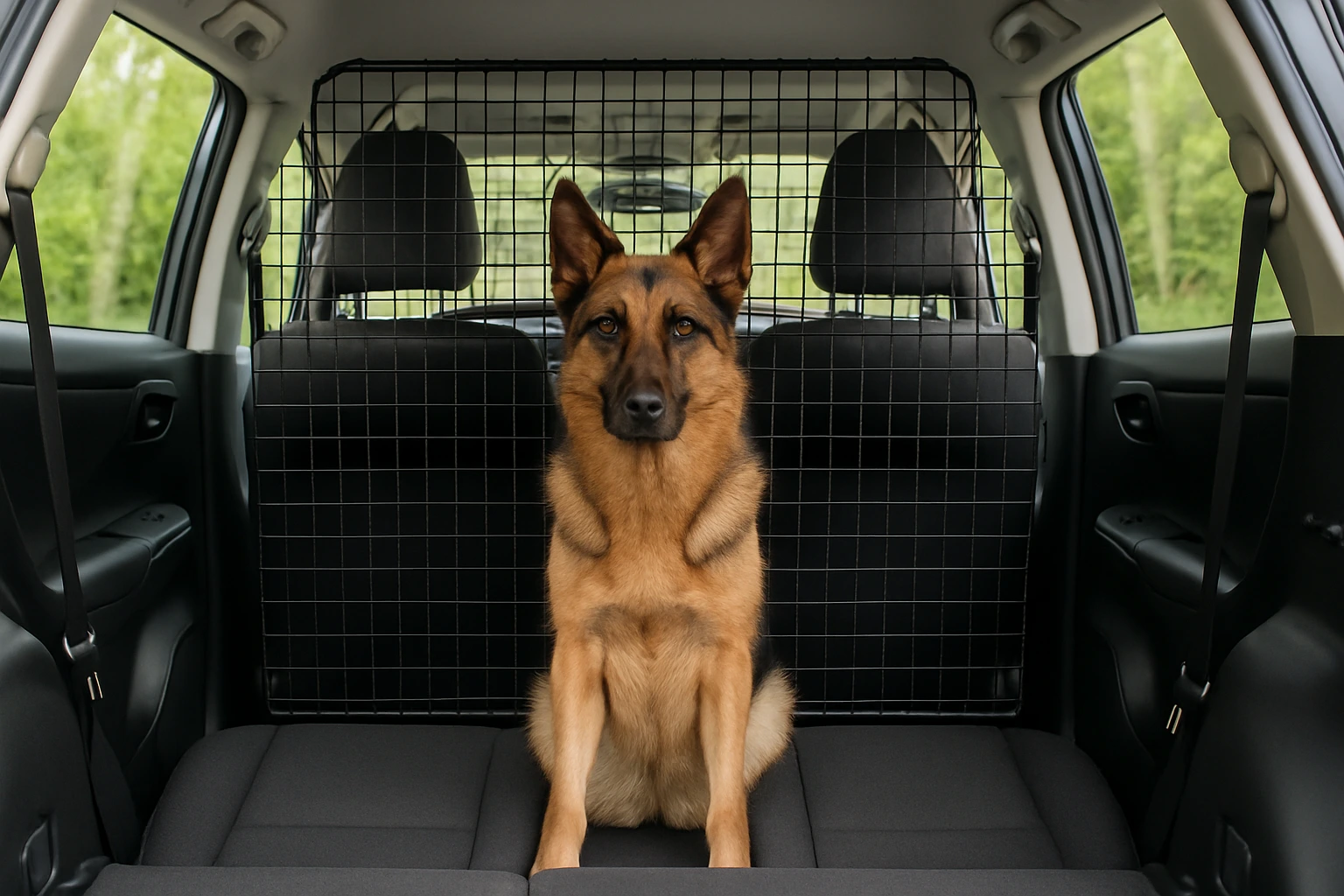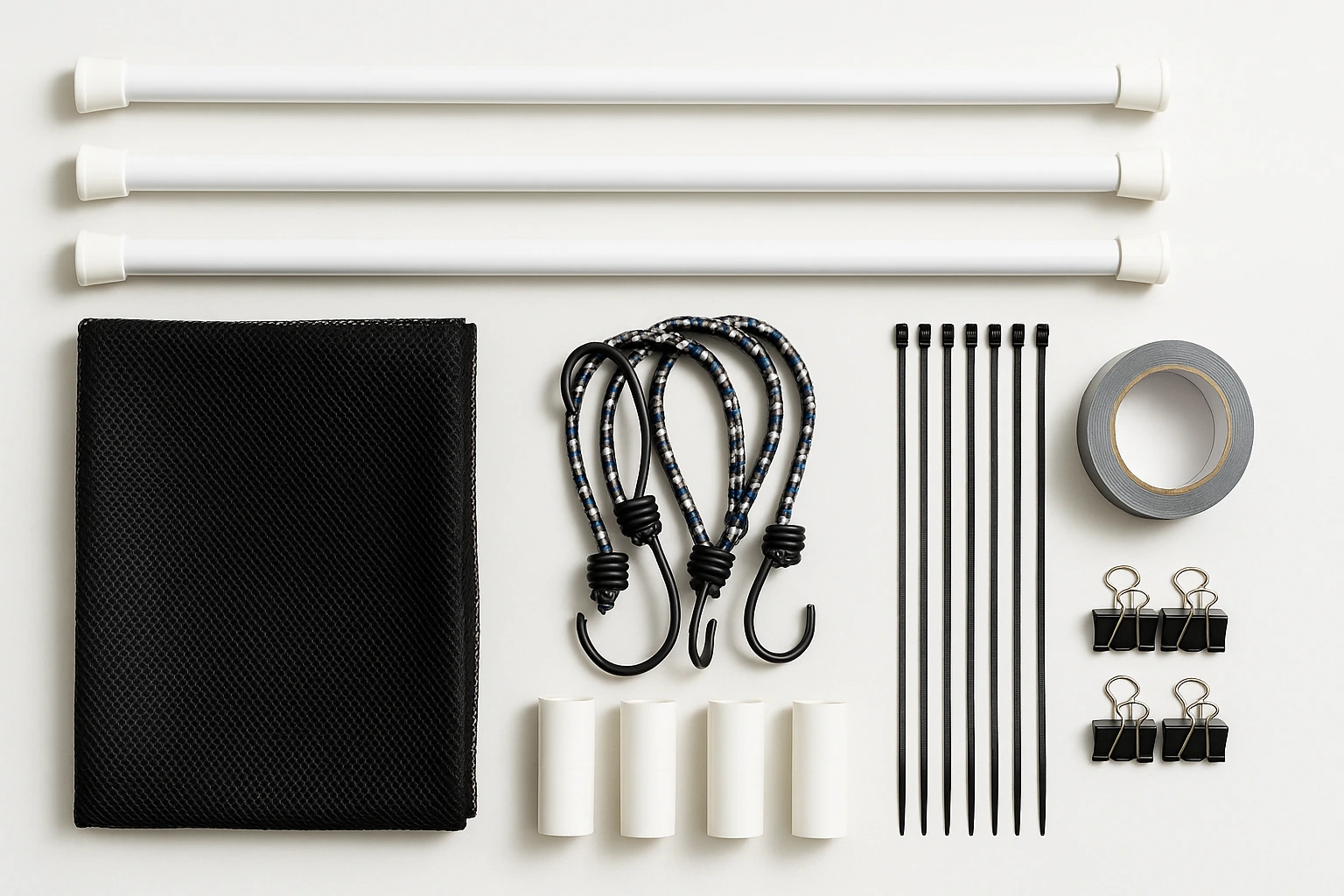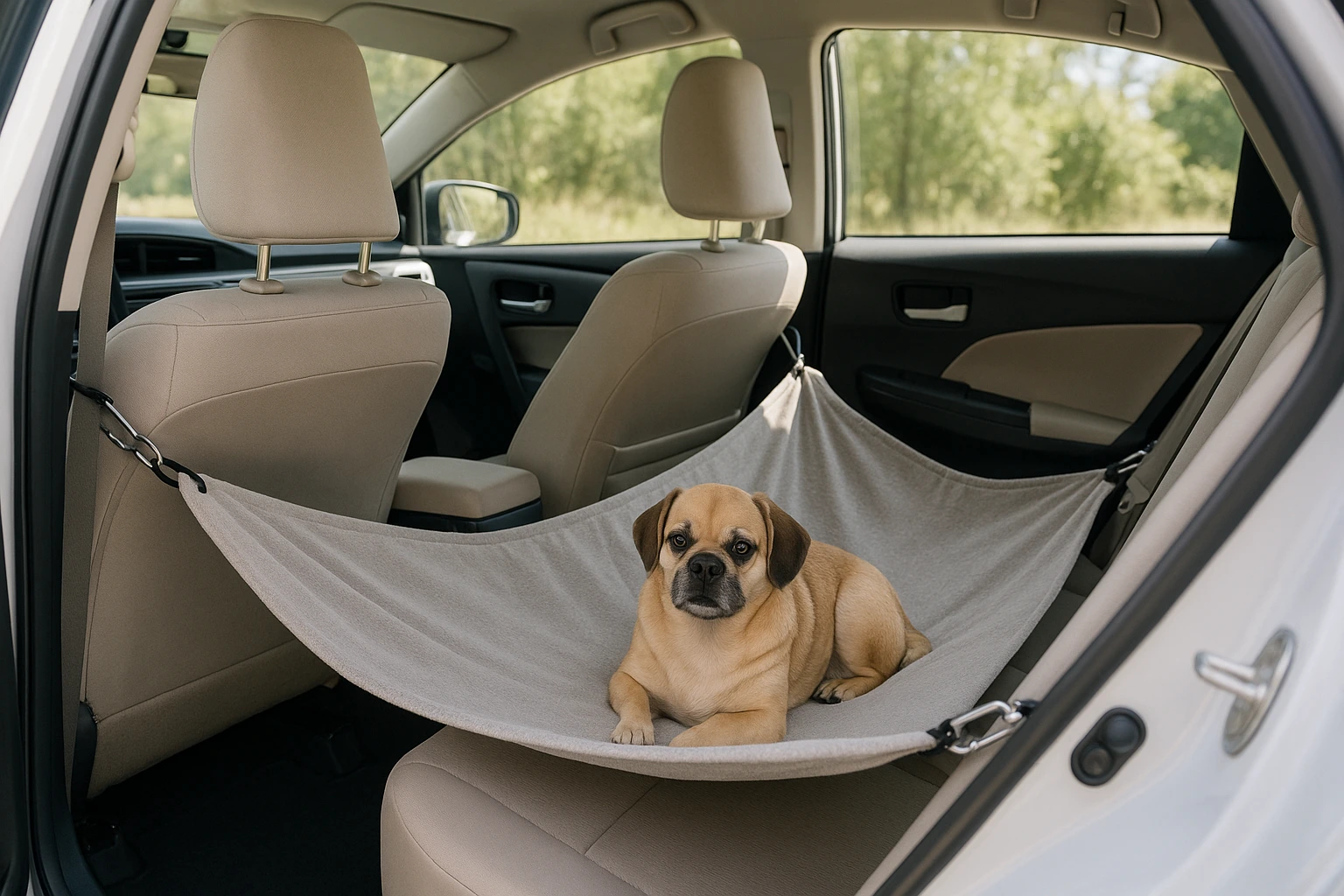
Imagine cruising down the highway, music playing, sun shining—until your pup pops a nose into your lap. Cute — but risky. A simple DIY pet barrier for car keeps paws in the back, cuts distractions, and makes cleanup less of a chore. Store-bought options can be pricey, but many of these builds use everyday items and start around $10 with no tools required. It’s just one of many clever fixes in our guide to diy pet projects, crafted to help you travel safely and affordably with your furry companion.
Find Your Perfect DIY Barrier!Table of Contents
- Why You Need a Pet Barrier
- Before You Start: Key Considerations
- 5 Budget-Friendly Pet Barrier Ideas
- Backseat vs. Cargo Area Setup
- On-the-Road Pet Safety Tips
- Best DIY Pet Barrier for Car (Selector)
- Maintaining Your Barrier
- Frequently Asked Questions
- When DIY Might Not Be Enough
- Conclusion
Why You Need a Pet Barrier
A car pet barrier keeps your co-pilot behind the line so you can drive, not referee. It reduces distractions and helps everyone during sudden stops. Here’s why a DIY car pet barrier is a must-have for pet owners on the road.

The Danger of Distraction
A quick glance at my pup once took my eyes off the road—scary on a busy highway! Unrestrained pets can:
- Jump into the front seat, obstructing your view or wheel.
- Snuggle in your lap, complicating quick maneuvers.
- Block mirrors or windows, hindering visibility.
- Chew wires or items, damaging your car. See our DIY Pet Cord Protector: 3 Quick Fixes Using Tools Under $10 for cable protection tips.
A homemade pet barrier keeps your pet in place, letting you focus on driving.
Protection During Sudden Stops
In a crash or sudden brake, an unrestrained pet can become a projectile. Even a 60-pound dog at 30 mph can exert well over 1,000 pounds of force, which could:
- Cause serious injuries like broken bones.
- Harm you or passengers if they collide with you.
- Increase vehicle damage.
A DIY car pet barrier, paired with a harness or crate, enhances car pet safety during sudden stops. Check this ASPCA article on pet travel safety for more tips.
Keeping Your Car Clean
Pets can leave fur, mud, or messes from car sickness. A car pet barrier confines these to one area, making cleanup easier. For budget-friendly tidying tips, see our guide on Frugal Pet Care: Save Money on Your Dog/Cat.
Legal Considerations
In some areas, unrestrained pets can lead to distracted driving fines. Rules differ by state and country — a quick check before you go can save you a ticket and a headache. A budget pet divider helps reduce distraction and may support compliance, but it’s not a substitute for required restraints where mandated.
This post contains affiliate links. If you buy through our links, we may earn a commission at no extra cost to you. Learn more.
Worried about your dog’s ride?
Quick, private chat with a veterinarian to confirm your setup and harness plan for your pet.
🐾 Vet advice online · 💬 Chat consultation · 🔒 Private & secure
Before You Start: Key Considerations
Before building your DIY car pet barrier, consider what suits your pet and vehicle:
- Pet Size and Temperament: Small, calm dogs need simple barriers; large, active ones require sturdy designs to prevent jumping or chewing.
- Vehicle Type: Sedans suit backseat barriers; SUVs or hatchbacks work well for cargo setups.
- Backseat vs. Cargo Area: Backseats are ideal for smaller pets; cargo areas offer space for bigger dogs.
- Visibility: Choose mesh barriers to maintain rearview mirror visibility.
- You still need a clean rearview; mesh beats solid fabric on long drives.
- Installation Ease: Opt for quick-setup designs if you need portability.
- Materials: Source affordable items like tension rods or mesh bags from Dollar Tree or Walmart. Choosing durable materials ensures safer pet transport. See our DIY Dog Collar Accessories: 10 Adorable Ideas for Under $15 for more budget ideas.
- Edge Cases: For my nervous pup, short drives with calming treats worked wonders. In compact cars, a hammock-style barrier saves space.
While a car pet barrier is great for containment, it’s not crash-tested. Always pair it with a harness or crate for maximum safety.
5 Budget-Friendly Pet Barrier Ideas
These five affordable DIY pet barrier ideas start around $10 if you already have some basics at home, offering effective ways to keep pets contained.
Price note: Costs are typical single-item prices. Total project cost may exceed $10 unless you already have some materials on hand or shop at discount/thrift stores.

Tension Rod & Mesh Curtain Combo
This lightweight, see-through pet barrier is a breeze to set up, perfect for small, calm dogs.
Best For: Small to medium, calm pets in backseats.
Materials Needed:
- 2-3 small tension rods ($1-$3 each at Dollar Tree).
- 1 large mesh laundry bag or fabric ($1-$5 at Walmart).
- Optional: Zip ties or binder clips ($0-$1).
How to Build:
- Extend a tension rod between the door frames behind the front seats (28–48 in / 71–122 cm fits most sedans).
- Add vertical rods to grab handles for stability, if needed.
- Drape mesh over the horizontal rod and secure with zip ties.
- Anchor the bottom to seat anchors or use another rod.
Pros: Affordable, easy to install, good visibility.
Cons: Not suited for strong pets, minimal crash protection.
Bungee Cord & Cargo Net System
This flexible barrier uses bungee cords and a net or blanket for versatility.
Best For: Medium to large pets in backseats or cargo areas.
Materials Needed:
- 4-6 bungee cords ($3-$7 at Walmart).
- 1 cargo net ($5-$9) or old blanket ($0).
How to Build:
- Hook bungee cords to top corners of the net/blanket and front headrests.
- Secure sides to door handles or seatbelt anchors.
- For cargo areas, anchor the bottom to floor hooks.
- Check for gaps to ensure containment.
Pros: Versatile, strong tension, quick setup.
Cons: Blankets can block your rearview. Metal bungee hooks may snag upholstery — swap for closed-loop carabiners or slip a short towel over each hook.
PVC Pipe Frame Barrier
This sturdy, custom-fit barrier uses PVC pipes for larger pets.
Best For: Medium to large pets in cargo areas.
Materials Needed:
- 1/2-inch PVC pipes ($3-$7 at Home Depot).
- PVC elbows/T-connectors ($2-$5).
- PVC cutter or saw ($0-$5).
- Mesh or tarp ($1-$5).
- Zip ties or duct tape ($0-$1).
How to Build:
- Measure and cut pipes for a frame fitting your car.
- Dry-fit the frame with elbows/T-connectors first; glue or tape only after you like the fit.
- Attach mesh to the frame with zip ties.
- Place in car, securing with bungee cords if needed.
Pros: Sturdy, custom-fit, durable.
Cons: More effort, less portable, may block visibility.
Repurposed Laundry Hamper Barrier
This quick setup uses a pop-up mesh hamper for small spaces.
Best For: Small to medium pets in backseats or cargo areas.
Materials Needed:
- 1 pop-up mesh hamper ($3-$7 at Dollar Tree).
- Optional: Zip ties or carabiners ($0-$1).
How to Build:
- Place the hamper behind the front seats or in the cargo area with the opening facing away from the driver.
- Secure top corners to headrests with zip ties.
- Anchor sides/bottom to prevent tipping.
Pros: Fast setup, cheap, collapsible.
Cons: Less durable, not for large pets.
Sheet/Blanket Hammock Setup
This hammock-style setup keeps pets contained in the backseat, preventing falls.
Best For: Small to medium pets in backseats.
Materials Needed:
- 1 old sheet or blanket ($0-$5 at thrift stores).
- 4 carabiners ($2-$6 at Walmart).
How to Build:
- Spread sheet across backseat, covering footwells.
- Loop front corners around front headrests and clip with carabiners.
- Secure back corners to rear headrests or seatbelt anchors.
- Adjust for a taut hammock.
Pros: Cheap, protects seats, prevents falls.
Cons: Not a true barrier; it can block the rearview mirror — do a quick visibility check before driving.

Backseat vs. Cargo Area Setup
Choosing the right spot for your car pet barrier depends on your vehicle and pet size. Backseats suit smaller pets, while cargo areas are ideal for larger dogs.
Backseat Setups for Car Pet Safety
Best For: Smaller pets or sedans without cargo space.
Recommended Methods: Tension rod, bungee net, laundry hamper, hammock.
Tips:
- Secure to headrests for stability.
- Avoid blocking rearview mirrors.
- Use a harness with the barrier for safety.
Cargo Area Setups
Best For: Larger dogs or SUVs/hatchbacks.
Recommended Methods: Bungee net, PVC frame, laundry hamper.
Tips:
- Use floor hooks or D-rings for anchoring.
- Ensure ventilation in cargo areas.
- Consider a crate for maximum safety.
Choosing the right cargo setup improves travel safety by preventing movement and injury during travel.
On-the-Road Pet Safety Tips
Pair your DIY car pet barrier with these simple habits for better car pet safety on every trip:
- Use a Harness or Crate: A crash-tested harness or crate is vital for crash protection.
- Harness Fit: Follow the manufacturer’s instructions for your dog’s size and weight; secure the harness to the seatbelt, not to a collar.
- Avoid Interference: Don’t block airbags or the seatbelt path, and make sure doors, latches, and belts still operate normally after installing a barrier.
- Test While Parked: Do a short test drive after installation and re-check all attachment points.
- Avoid Leaving Pets Alone: Cars can overheat quickly, even with cracked windows.
- Plan Breaks: Stop every 2-3 hours for water, exercise, and relief.
- Provide Water: Use a spill-proof travel bowl.
- Ensure Ventilation: Keep air flowing, avoiding full window exposure.
- Acclimate Pets: Start with short trips, using treats for positive reinforcement.
- Avoid Pre-Trip Meals: Prevent car sickness by feeding hours before travel.
- Pack a Kit: Include food, water, leash, waste bags, and comfort items. See our How to Start a Pet Accessories Business: 5 Essential Tools for Beginners for more ideas.
- Two-finger rule: you should slide two fingers under chest straps—snug, not tight.
- Anchor correctly: clip to the seatbelt path or car tether point (never to a collar).
- Do a brake test in a parking lot and recheck all buckles and adjusters.
Get quick reassurance for your pet
Share anxiety cues or fit questions and get practical next steps from a veterinarian before you drive.
🐾 Vet advice online · 💬 Chat consultation · 🔒 Private & secure
Best DIY Pet Barrier for Car (Selector)
This selector helps you find the best DIY car pet barrier based on your vehicle and your pet’s size and behavior.
Maintaining Your Barrier
A minute of upkeep goes a long way — try these quick checks:
- Inspect Regularly: Check for loose connections or torn fabric before trips.
- Clean Often: Wash mesh or fabric per instructions; wipe PVC pipes. Try our Homemade Cleaning Solution for Jewelry: 3-Ingredient Recipe That Works for pet gear.
- Store Properly: Stow tension rods or disassemble PVC frames when not in use.
- Reinforce as Needed: Add zip ties or extra rods if your pet pushes or jumps.
Frequently Asked Questions
When DIY Might Not Be Enough
While a DIY car pet barrier is budget-friendly, it’s not ideal for every scenario:
- Big, Rowdy Dogs: Strong chewers or jumpers may break through. Opt for a crash-tested commercial barrier or crate.
- Crash Safety: These barriers focus on containment, not accident protection. Use a harness or crate for safety.
- Daily Use: For frequent trips, a store-bought barrier may be more durable.
Combine your car’s pet barrier with a harness or crate for the safest rides and overall safer travel.
Ask a vet before your next trip
Tailored guidance for motion sickness or travel anxiety—so you both ride calmer.
🐾 Vet advice online · 💬 Chat consultation · 🔒 Private & secure
Conclusion
You don’t need to spend a fortune to keep your dog safe on car trips. These five DIY pet barrier ideas, starting around $10, offer clever solutions like a DIY car pet barrier using tension rods, bungee nets, or PVC frames for safe, budget-friendly travel. I had fun building my own barrier, and now I drive worry-free with my furry sidekick—you can too! Choose a design that suits your pet and vehicle for safe, budget-friendly travel. With a DIY car pet barrier, you can enjoy worry-free road trips with your pet at a fraction of the cost. Each of these ideas supports pet travel safety while saving you serious money over store-bought alternatives.
For more creative and affordable pet solutions, check out our comprehensive DIY Pet Projects Guide to enhance your pet’s life on a budget.
Disclaimer: The DIY pet barriers described in this article are intended for pet containment and convenience, not as crash-tested safety devices. For optimal safety, always use a crash-tested harness (never a collar) or crate in conjunction with any pet barrier. Do not block airbags or the seatbelt path, and verify normal door and belt operation after installation. Laws vary by location—check any restraint requirements in your area. Consult a veterinarian or pet safety expert for personalized advice. This information is general and not a substitute for professional guidance.